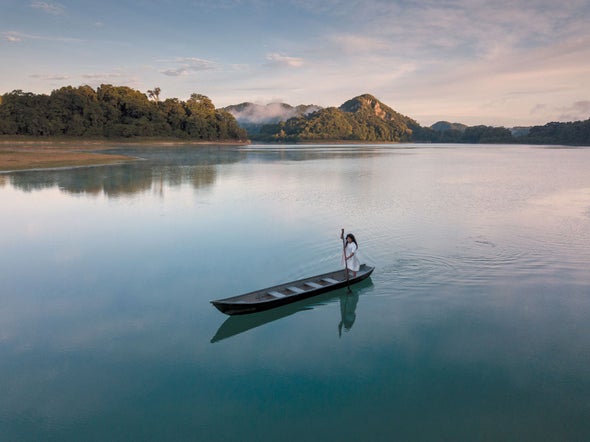Some 550 years ago the last of the great city-states of the Maya civilization that had flourished in the Americas for centuries met their demise. As drought and warfare tore apart the social and political fabric and the Spanish conquistadors began claiming Maya land for plantations and subjugating Maya people to work on them, many residents of storied stone cities such as Yaxchilan and Palenque fled to the countryside in search of a better life. Ultimately they founded a host of new Maya cultures. Some people, known as the Lacandon Maya, established themselves in the forests around Lake Mensabak in the southern Mexican state of Chiapas. Their descendants still live in this region today. They are the Hach Winik, “the true people” in Yucatec Mayan.
For decades anthropologists thought these modern-day Lacandon were a time capsule of sorts, a Maya group that had survived the collapse and subsequent Spanish conquest intact, unchanged for hundreds of years. Starting in the 1980s, however, as researchers learned more about the Lacandon, it became clear that this was not the case. Although it incorporated elements of classic Maya culture, the Lacandon way of life was distinctive.
For the past 17 years archaeologists Joel Palka of Arizona State University and Fabiola Sanchez Balderas, president of Xanvil, a Mexican organization that studies and supports Maya culture, have been collaborating with the modern Lacandon Maya to learn what they can about the birth of their culture and to understand how their ancestors adapted to a world that was being radically reshaped by forces outside their control. The team's excavations at various sites around Lake Mensabak are the first to explore the Lacandon past. The research is yielding a detailed picture of the lives of Maya people who survived colonialism to carry on the traditions of their ancestors while developing customs, beliefs and survival strategies of their own.
Sacred landscape of Lake Mensabak contains dozens of spiritually important sites. One of the most significant is a limestone cliff that is believed to be both the home of Mensabak—the god of agriculture and rain—and the gateway to the heaven of Mensabak, where the Lacandon people go when they die.
At the base of the cliff lies a bone shrine containing the remains of people who may have been some of the first Lacandon. The skulls have flattened foreheads and craniums that were shaped into two separate lobes during early childhood when the bone was pliable.
Clay pots bearing the faces of gods accompany the bones. Each god pot overflows with a tarry substance that is left over when resin from the seed pods of copal trees is burned and prayers are chanted over the fragrant smoke. Archaeologists draw a direct connection between these god pots and the elaborate ceramic incensarios that Maya people used to make offerings to their gods for 3,000 years. It is one of many examples of cultural continuity between the Lacandon and the ancient Maya.
The Lacandon were not isolated in this area of southern Mexico—and they appear to have fought extensively with neighboring Maya groups. Excavations at a site called Tzibana on the eastern side of the lake are revealing how the Lacandon defended their territory. There, among the village ruins, the archaeologists have found the remains of a defensive wall that was built between two pyramids, which form a choke point in the landscape. Constructed from uncut chunks of limestone, the wall stands a few feet high. Team member Josuhé Lozada Toledo of Mexico's National Institute of Anthropology and History thinks that warriors stood on the wall behind a taller wood palisade, which would have given them cover as they fought with spears and javelins. The hillside below the wall was planted with piñuela, a species of agave that has sharp spines along the edges of its leaves, forming a kind of natural barbed wire. Tzibana may have been the first line of defense against attackers coming from the east.
City dwellers moved to the countryside in search of not only farmland and water for irrigation but also places that held spiritual forces they believed could protect them from a world that offered enemies in every direction. “It wasn't just natural resources but supernatural resources” that drew the Maya to Lake Mensabak, Joel Palka says. Evidence of religion as a driving force in Lacandon society is everywhere here. Ancient paintings of gods and spiritually significant animals adorn the limestone cliffs at Tzibana and other sites around the lake.
A carved serpent at the base of the Tzibana cliffs resembles the Aztec feathered serpent god Quetzalcoatl, according to Palka, and may reflect the influence of the Aztecs on the Lacandon.
El Mirador mountain bridges the underworld (represented by the lake), the world of the living (represented by the land) and the heavens (represented by the sky), according to the Lacandon. They believe that the god Chak Aktun lives here. Palka observes that this mountain rising from the waters of a lake is a natural version of the altepetl ("water mountain"), a concept that formed the basis for Maya and Aztec communities.
The temple pyramids that dominated their stone cities were human-made altepetls. Roughly 2,000 years ago the ancient Maya leveled the top of Mirador and built a massive temple platform there. The team has also found remnants of terraces that form what may have been a pilgrimage route up the side of the mountain to the temple, where visitors would make offerings to Chak Aktun for good health and bountiful crops.
The families live in a village at the southern end of the lake with two churches, an administrative building where a small police force is headquartered, four tiendas that sell essential goods and snacks, and a new tourist center. People grow food for their personal consumption in nearby fields called milpas. A gravel road connects the village to the world outside the rain forest. The Mexican government designated the territory around the lake as the Metzabok Floral and Faunal Protection Area, which offers the land some legal protections that help the Lacandon people to maintain their way of life. They also receive some income from the Mexican government for taking care of the protected area. Rafael Tarano, like his ancestors who settled this area in the aftermath of the Spanish conquest, views religion as essential to meeting whatever challenges the future holds. “I don't know who the true god is, Hesuklisto [Jesus Christ] or Hachakyum,” he says, “but in bad times it is believe or die.”
As a child, Tarano learned the stories of the Lacandon gods—from Mensabak and Chak Aktun to Hachakyum, the supreme creator, to Akyantho, god of foreigners and technology. He also learned how to make the traditional Lacandon offerings at the sacred sites around the lake. But times have changed—and the Lacandon have changed with them. No one makes the offerings anymore, Tarano says. Everyone in the community—about 19 families in all—has either converted to evangelical Christianity or does not practice a religion at all, Fabiola Sanchez Balderas explains.



